
GraphRAG-Local-UI
GraphRAG using Local LLMs - Features robust API and multiple apps for Indexing/Prompt Tuning/Query/Chat/Visualizing/Etc. This is meant to be the ultimate GraphRAG/KG local LLM app.
Stars: 800
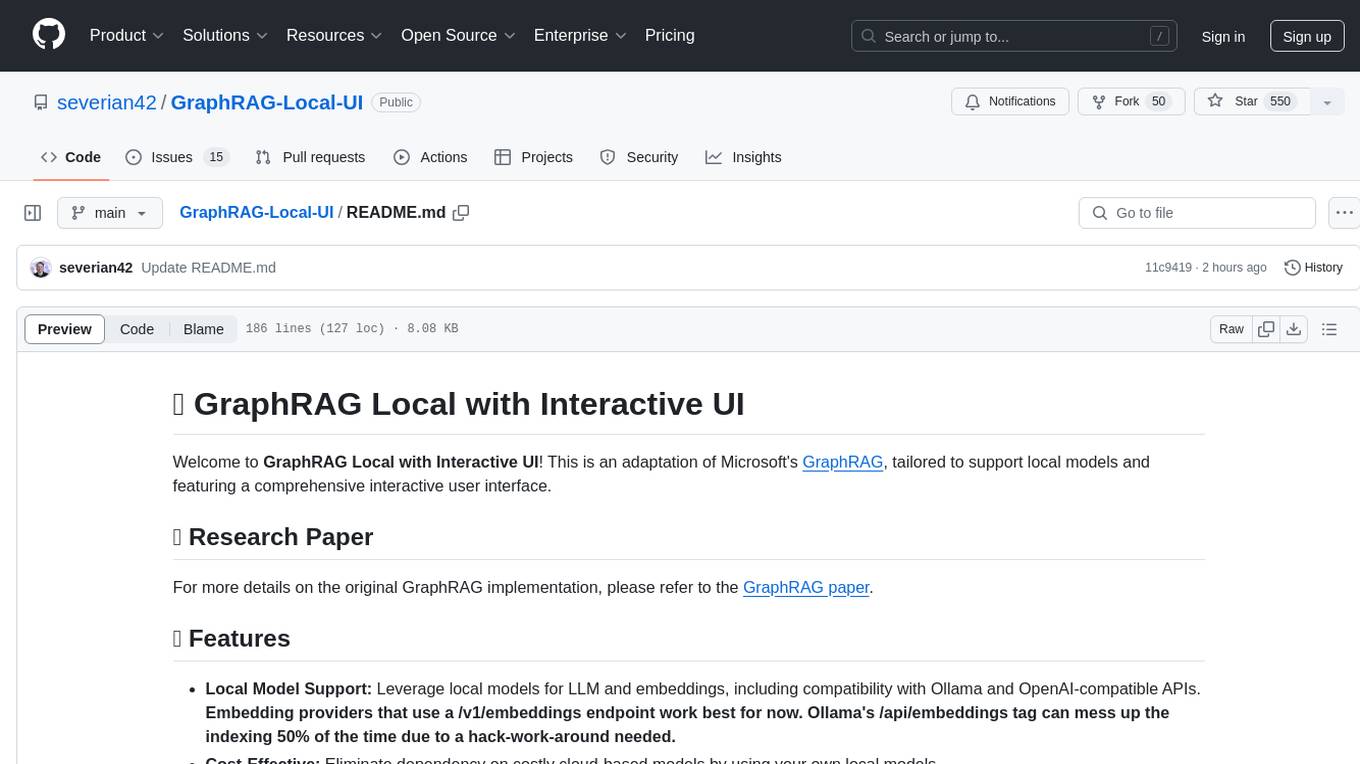
GraphRAG Local with Interactive UI is an adaptation of Microsoft's GraphRAG, tailored to support local models and featuring a comprehensive interactive user interface. It allows users to leverage local models for LLM and embeddings, visualize knowledge graphs in 2D or 3D, manage files, settings, and queries, and explore indexing outputs. The tool aims to be cost-effective by eliminating dependency on costly cloud-based models and offers flexible querying options for global, local, and direct chat queries.
README:
Welcome to GraphRAG Local with Index/Prompt-Tuning and Querying/Chat UIs! This project is an adaptation of Microsoft's GraphRAG, tailored to support local models and featuring a comprehensive interactive user interface ecosystem.
For more details on the original GraphRAG implementation, please refer to the GraphRAG paper.
-
API-Centric Architecture: A robust FastAPI-based server (
api.py) serving as the core of the GraphRAG operations. -
Dedicated Indexing and Prompt Tuning UI: A separate Gradio-based interface (
index_app.py) for managing indexing and prompt tuning processes. - Local Model Support: Leverage local models for LLM and embeddings, including compatibility with Ollama and OpenAI-compatible APIs.
- Cost-Effective: Eliminate dependency on costly cloud-based models by using your own local models.
- Interactive UI: User-friendly interface for managing data, running queries, and visualizing results (main app).
- Real-time Graph Visualization: Visualize your knowledge graph in 2D or 3D using Plotly (main app).
- File Management: Upload, view, edit, and delete input files directly from the UI.
- Settings Management: Easily update and manage your GraphRAG settings through the UI.
- Output Exploration: Browse and view indexing outputs and artifacts.
- Logging: Real-time logging for better debugging and monitoring.
- Flexible Querying: Support for global, local, and direct chat queries with customizable parameters (main app).
- Customizable Visualization: Adjust graph layout, node sizes, colors, and more to suit your preferences (main app).
Important Note: The GraphRAG Local UI ecosystem is currently undergoing a major transition. While the main app remains functional, I am actively developing separate applications for Indexing/Prompt Tuning and Querying/Chat, all built around a robust central API. Users should expect some changes and potential instability during this transition period.
While it is currently functional, it has only been primarily tested on a Mac Studio M2.
My vision for the GraphRAG Local UI ecosystem is to become the ultimate set of tools for working with GraphRAG and local LLMs, incorporating as many cool features and knowledge graph tools as possible. I am continuously working on improvements and new features.
- [x] New API-centric architecture (
api.py) - [x] Dedicated Indexing and Prompt Tuning UI (
index_app.py) - [x] Improved file management and output exploration
- [x] Background task handling for long-running operations
- [x] Enhanced configuration options through environment variables and YAML files
- [ ] Dedicated Querying/Chat UI that interacts with the API
- [ ] Dockerfile for easier deployment
- [ ] Launch your own GraphRAG API server for use in external applications
- [ ] Experimental: Mixture of Agents for Indexing/Query of knowledge graph
- [ ] Support for more file formats (CSV, PDF, etc.)
- [ ] Web search/Scraping capabilities
- [ ] Advanced graph analysis tools
- [ ] Integration with popular knowledge management tools
- [ ] Collaborative features for team-based knowledge graph building
I am committed to making the GraphRAG Local UI ecosystem the most comprehensive and user-friendly toolset for working with knowledge graphs and LLMs. Your feedback and suggestions are much needed in shaping the future of this project.
Feel free to open an Issue if you run into an error, and I will try to address it as soon as possible to minimize any downtime you might experience.
Follow these steps to set up and run the GraphRAG Local UI ecosystem:
-
Create and activate a new conda environment:
conda create -n graphrag-local -y conda activate graphrag-local
-
Install the required packages:
First install the GraphRAG dir from this repo (has changes not present in the Microsoft repo):
pip install -e ./graphrag
Then install the rest of the dependencies:
pip install -r requirements.txt
-
Launch the API server:
python api.py --host 0.0.0.0 --port 8012 --reload
-
If using Ollama for embeddings, launch the embedding proxy:
python embedding_proxy.py --port 11435 --host http://localhost:11434
Note: For detailed instructions on using Ollama embeddings with GraphRAG, refer to the EMBEDDING_PROXY_README.md file.
-
Launch the Indexing and Prompt Tuning UI:
gradio index_app.py
-
Launch the main interactive UI (legacy app):
gradio app.py
or
python app.py
-
Access the UIs:
- Indexing and Prompt Tuning UI: Open your web browser and navigate to
http://localhost:7861 - Main UI (legacy): Open your web browser and navigate to
http://localhost:7860
- Indexing and Prompt Tuning UI: Open your web browser and navigate to
GraphRAG is designed for flexibility, allowing you to quickly create and initialize your own indexing directory. Follow these steps to set up your environment:
This repo comes with a pre-made Indexing folder but you may want to make your own, so here are the steps. First, create the required directory structure for your input data and indexing results:
mkdir -p ./indexing/inputThis directory will store:
- Input .txt files for indexing
- Output results
- Prompts for Prompt Tuning
If you want to start with sample data, copy it to your new input directory:
cp input/* ./indexing/inputYou can also add your own .txt files to this directory for indexing.
Run the following command to initialize the ./indexing folder with the required files:
python -m graphrag.index --init --root ./indexingMove the pre-configured settings.yaml file to your indexing directory:
mv settings.yaml ./indexingThis file contains the main configuration, pre-set for use with local models.
You can customize your setup by modifying the following environment variables:
-
ROOT_DIR: Points to your main indexing directory -
INPUT_DIR: Specifies the location of your input files
For more detailed information and advanced usage, refer to the official GraphRAG documentation.
The GraphRAG Local UI ecosystem consists of three main components, each serving a specific purpose in the knowledge graph creation and querying process:
The api.py file serves as the backbone of the GraphRAG system, providing a robust FastAPI-based server that handles all core operations.
Key features:
- Manages indexing and prompt tuning processes
- Handles various query types (local, global, and direct chat)
- Integrates with local LLM and embedding models
- Provides endpoints for file management and system configuration
Usage:
python api.py --host 0.0.0.0 --port 8012 --reloadNote: If using Ollama for embeddings, make sure to run the embedding proxy (embedding_proxy.py) alongside api.py. Refer to the EMBEDDING_PROXY_README.md for detailed instructions.
- Start the Core API (
api.py) to enable backend functionality. - If using Ollama for embeddings, start the embedding proxy (
embedding_proxy.py). - Use the Indexing and Prompt Tuning UI (
index_app.py) to prepare your data and fine-tune the system. - (Optional) Use the Main Interactive UI (
app.py) for visualization and legacy features.
This modular approach allows for greater flexibility and easier maintenance of the GraphRAG system. As development continues, the functionality of app.py will be gradually integrated into new, specialized interfaces that interact with the core API.
The index_app.py file provides a user-friendly Gradio interface for managing the indexing and prompt tuning processes.
Key features:
- Configure and run indexing tasks
- Set up and execute prompt tuning
- Manage input files and explore output data
- Adjust LLM and embedding settings
Usage:
python index_app.pyAccess the UI at http://localhost:7861
The app.py file is the pre-existing main application, which is being phased out but still provides useful functionality.
Key features:
- Visualize knowledge graphs in 2D or 3D
- Run queries and view results
- Manage GraphRAG settings
- Explore indexed data
Usage:
python app.pyor
gradio app.pyAccess the UI at http://localhost:7860
- Start the Core API (
api.py) to enable backend functionality. - Use the Indexing and Prompt Tuning UI (
index_app.py) to prepare your data and fine-tune the system. - (Optional) Use the Main Interactive UI (
app.py) for visualization and legacy features.
This modular approach allows for greater flexibility and easier maintenance of the GraphRAG system. As development continues, the functionality of app.py will be gradually integrated into new, specialized interfaces that interact with the core API.
- Original GraphRAG repository by Microsoft: GraphRAG
- This project took inspiration and used the GraphRAG4OpenWebUI repository by win4r (https://github.com/win4r/GraphRAG4OpenWebUI) as a starting point for the API implementation.
- If you encounter any issues with the new API or Indexing UI, please check the console logs for detailed error messages.
- For the main app, if you can't run
gradio app.py, try runningpip install --upgrade gradioand then exit out and start a new terminal. It should then load and launch properly as a Gradio app. - On Windows, if you run into an encoding/UTF error, you can change it to the correct format in the YAML Settings menu.
For any issues or feature requests, please open an issue on the GitHub repository. Happy knowledge graphing!
For Tasks:
Click tags to check more tools for each tasksFor Jobs:
Alternative AI tools for GraphRAG-Local-UI
Similar Open Source Tools

GraphRAG-Local-UI
GraphRAG Local with Interactive UI is an adaptation of Microsoft's GraphRAG, tailored to support local models and featuring a comprehensive interactive user interface. It allows users to leverage local models for LLM and embeddings, visualize knowledge graphs in 2D or 3D, manage files, settings, and queries, and explore indexing outputs. The tool aims to be cost-effective by eliminating dependency on costly cloud-based models and offers flexible querying options for global, local, and direct chat queries.
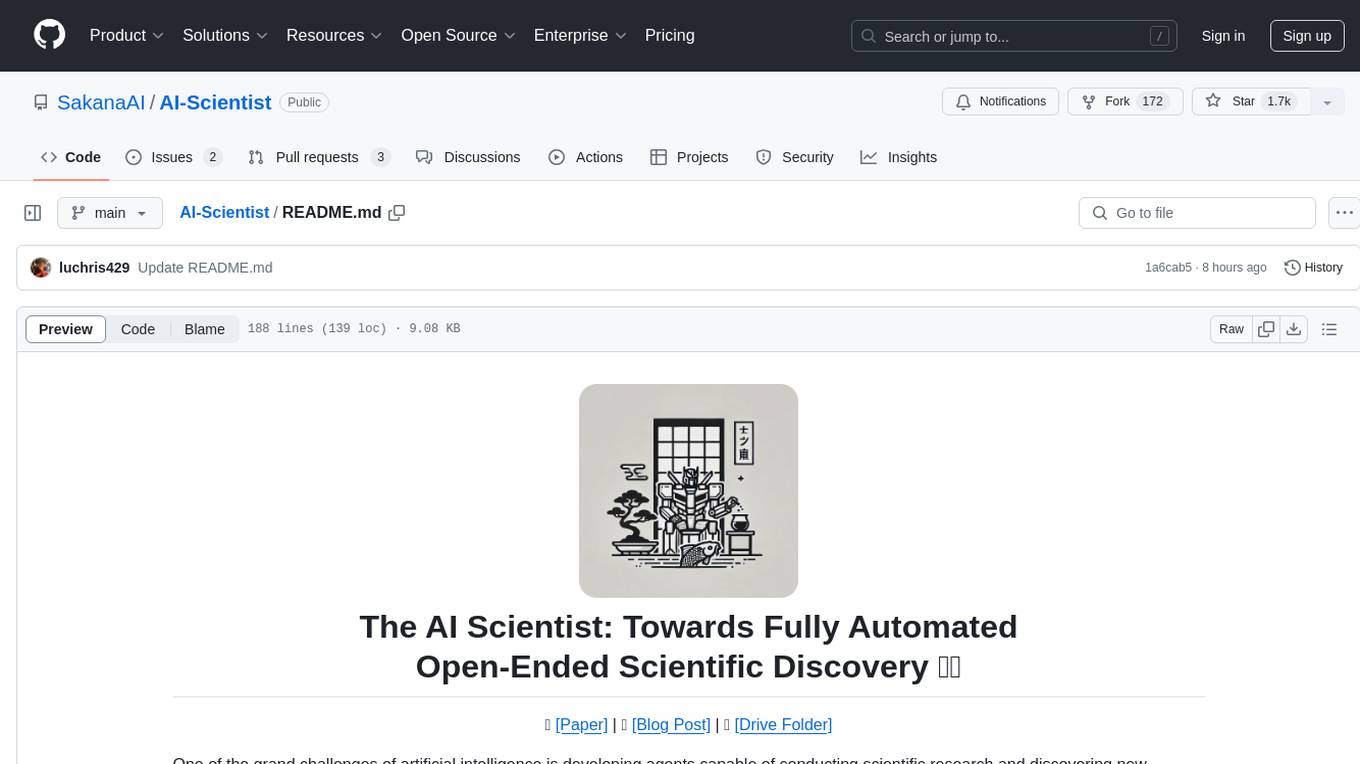
AI-Scientist
The AI Scientist is a comprehensive system for fully automatic scientific discovery, enabling Foundation Models to perform research independently. It aims to tackle the grand challenge of developing agents capable of conducting scientific research and discovering new knowledge. The tool generates papers on various topics using Large Language Models (LLMs) and provides a platform for exploring new research ideas. Users can create their own templates for specific areas of study and run experiments to generate papers. However, caution is advised as the codebase executes LLM-written code, which may pose risks such as the use of potentially dangerous packages and web access.
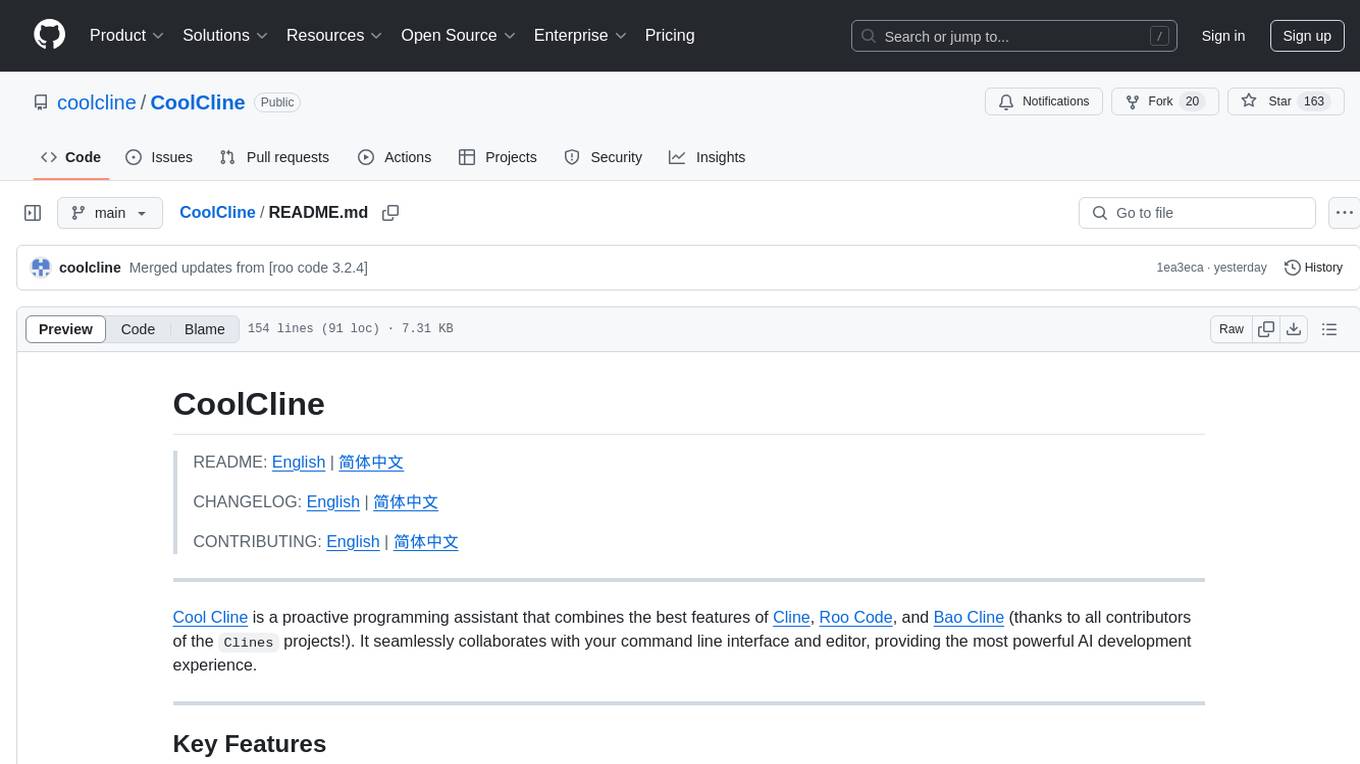
CoolCline
CoolCline is a proactive programming assistant that combines the best features of Cline, Roo Code, and Bao Cline. It seamlessly collaborates with your command line interface and editor, providing the most powerful AI development experience. It optimizes queries, allows quick switching of LLM Providers, and offers auto-approve options for actions. Users can configure LLM Providers, select different chat modes, perform file and editor operations, integrate with the command line, automate browser tasks, and extend capabilities through the Model Context Protocol (MCP). Context mentions help provide explicit context, and installation is easy through the editor's extension panel or by dragging and dropping the `.vsix` file. Local setup and development instructions are available for contributors.
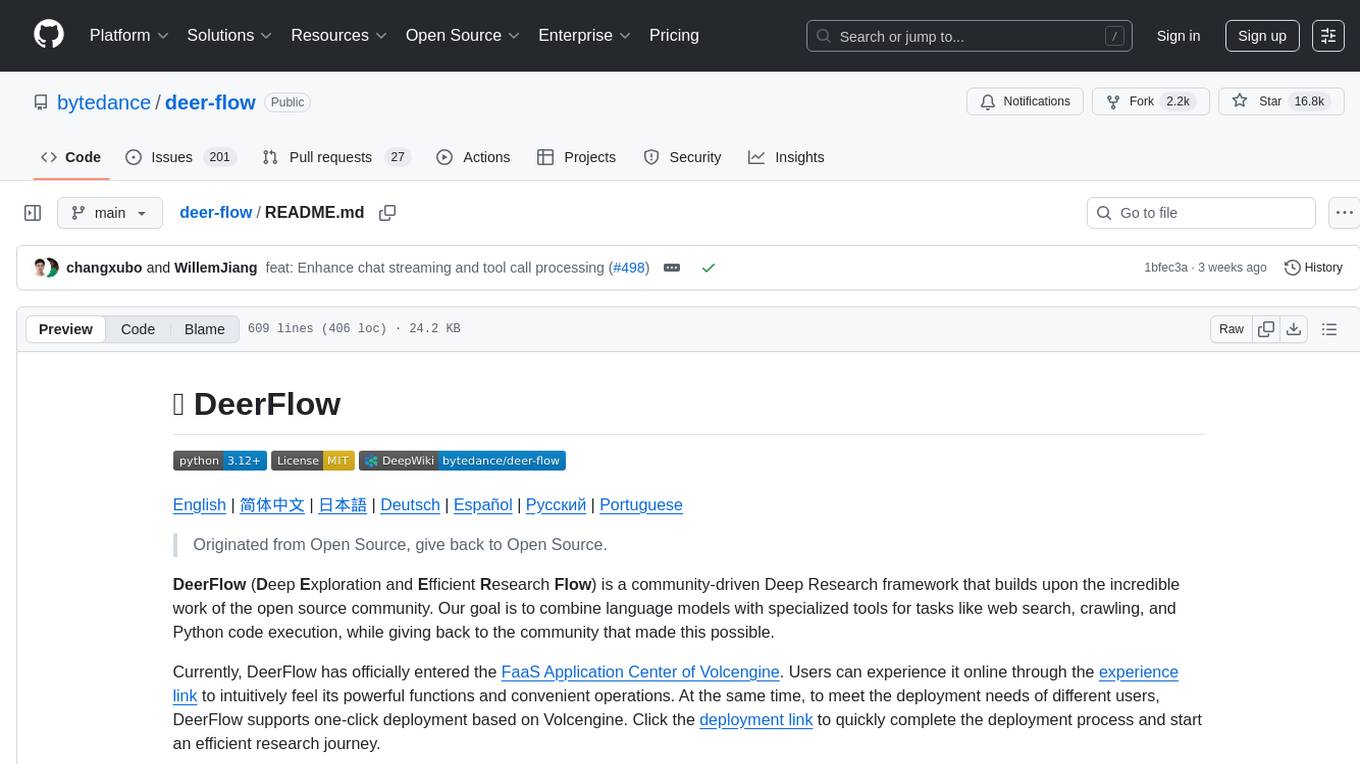
deer-flow
DeerFlow is a community-driven Deep Research framework that combines language models with specialized tools for tasks like web search, crawling, and Python code execution. It supports FaaS deployment and one-click deployment based on Volcengine. The framework includes core capabilities like LLM integration, search and retrieval, RAG integration, MCP seamless integration, human collaboration, report post-editing, and content creation. The architecture is based on a modular multi-agent system with components like Coordinator, Planner, Research Team, and Text-to-Speech integration. DeerFlow also supports interactive mode, human-in-the-loop mechanism, and command-line arguments for customization.
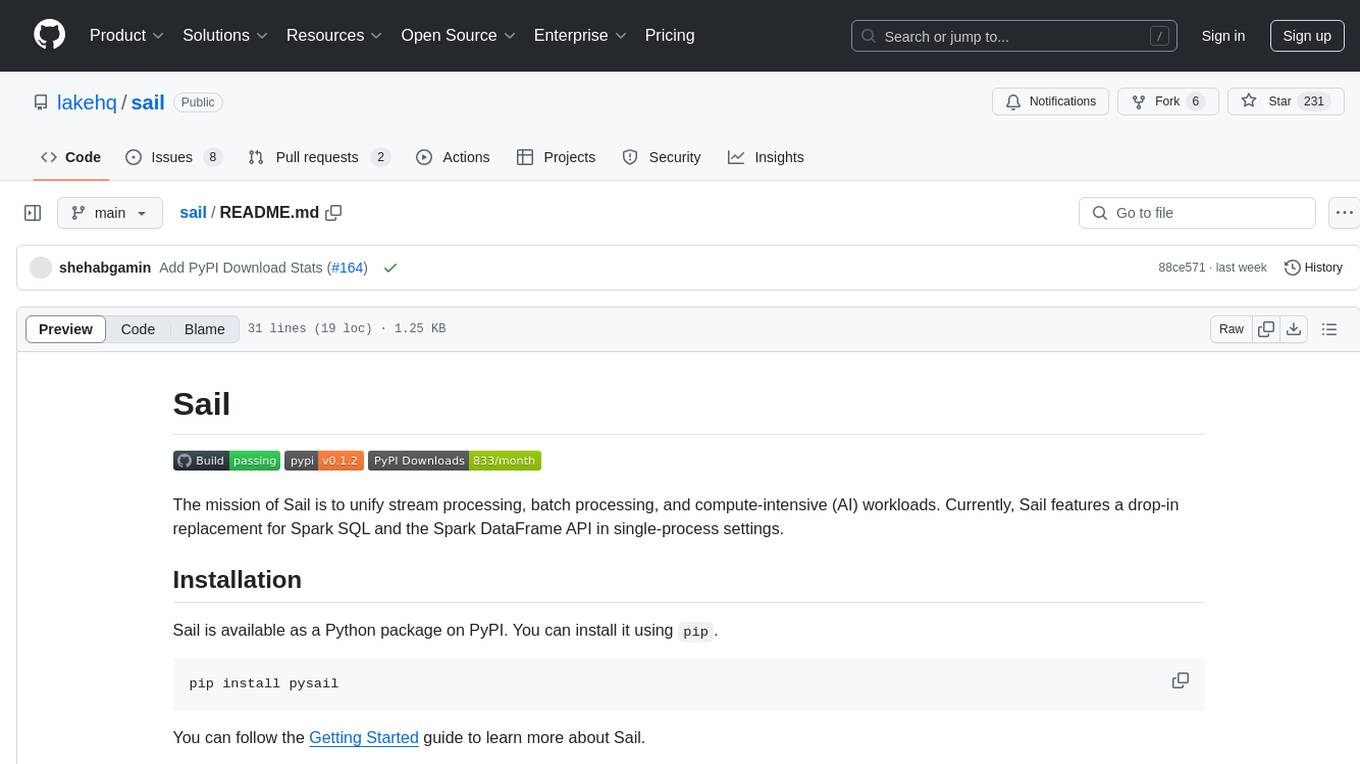
sail
Sail is a tool designed to unify stream processing, batch processing, and compute-intensive workloads, serving as a drop-in replacement for Spark SQL and the Spark DataFrame API in single-process settings. It aims to streamline data processing tasks and facilitate AI workloads.
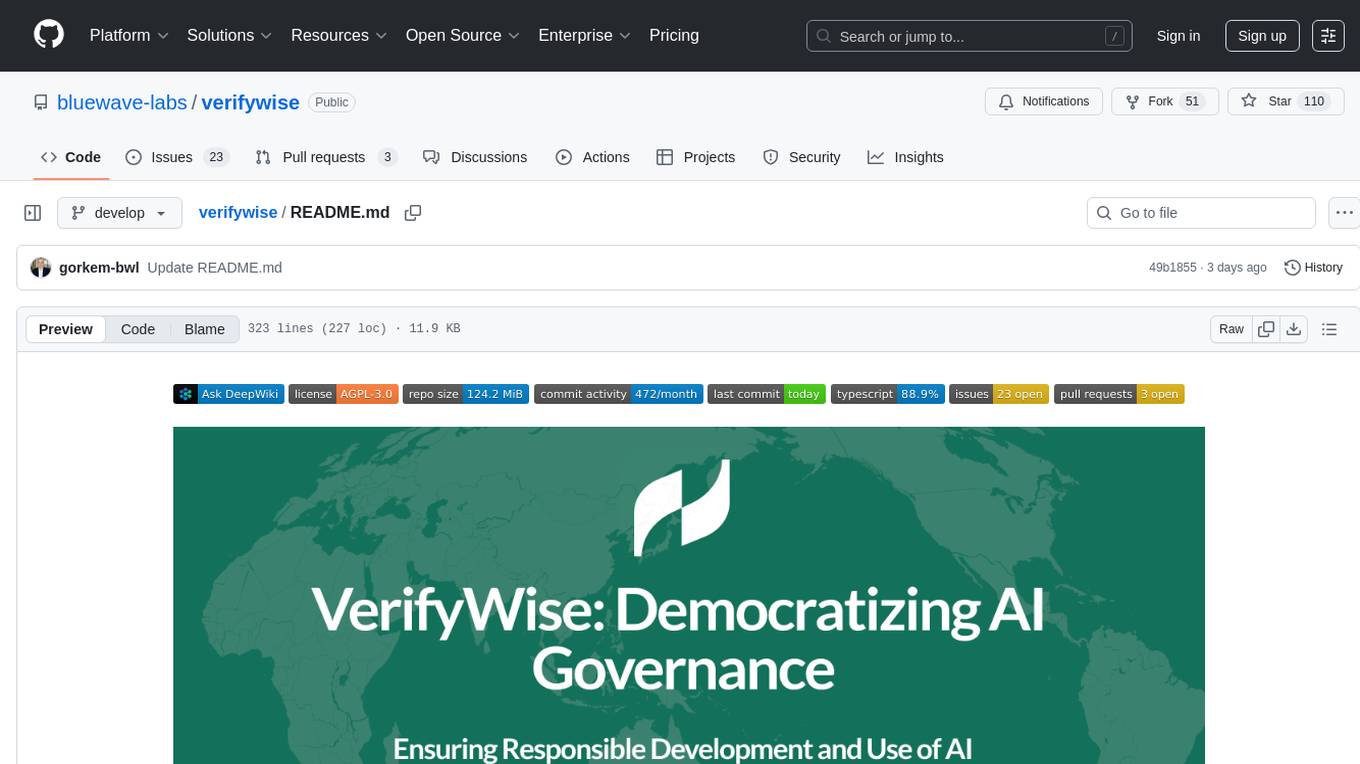
verifywise
VerifyWise is an open-source AI governance platform designed to help businesses harness the power of AI safely and responsibly. The platform ensures compliance and robust AI management without compromising on security. It offers additional products like MaskWise for data redaction, EvalWise for AI model evaluation, and FlagWise for security threat monitoring. VerifyWise simplifies AI governance for organizations, aiding in risk management, regulatory compliance, and promoting responsible AI practices. It features options for on-premises or private cloud hosting, open-source with AGPLv3 license, AI-generated answers for compliance audits, source code transparency, Docker deployment, user registration, role-based access control, and various AI governance tools like risk management, bias & fairness checks, evidence center, AI trust center, and more.
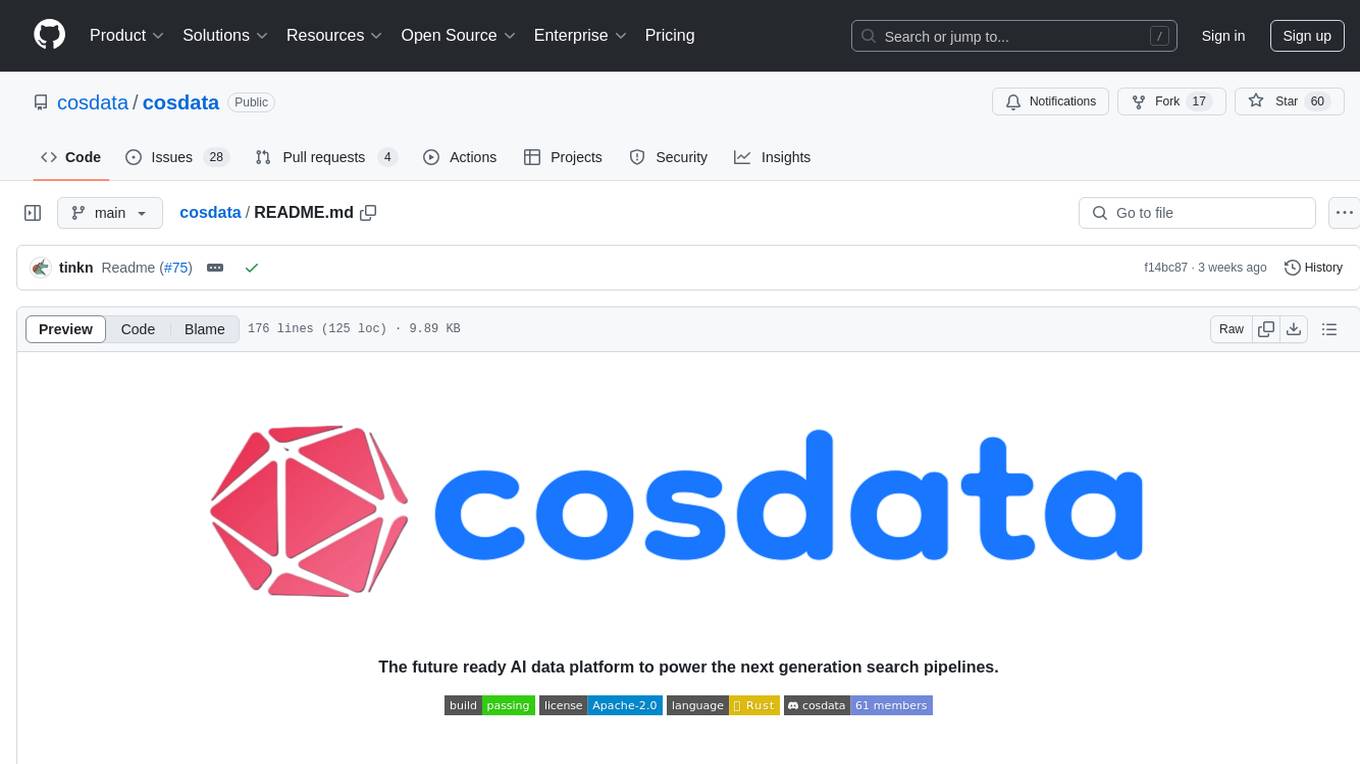
cosdata
Cosdata is a cutting-edge AI data platform designed to power the next generation search pipelines. It features immutability, version control, and excels in semantic search, structured knowledge graphs, hybrid search capabilities, real-time search at scale, and ML pipeline integration. The platform is customizable, scalable, efficient, enterprise-grade, easy to use, and can manage multi-modal data. It offers high performance, indexing, low latency, and high requests per second. Cosdata is designed to meet the demands of modern search applications, empowering businesses to harness the full potential of their data.
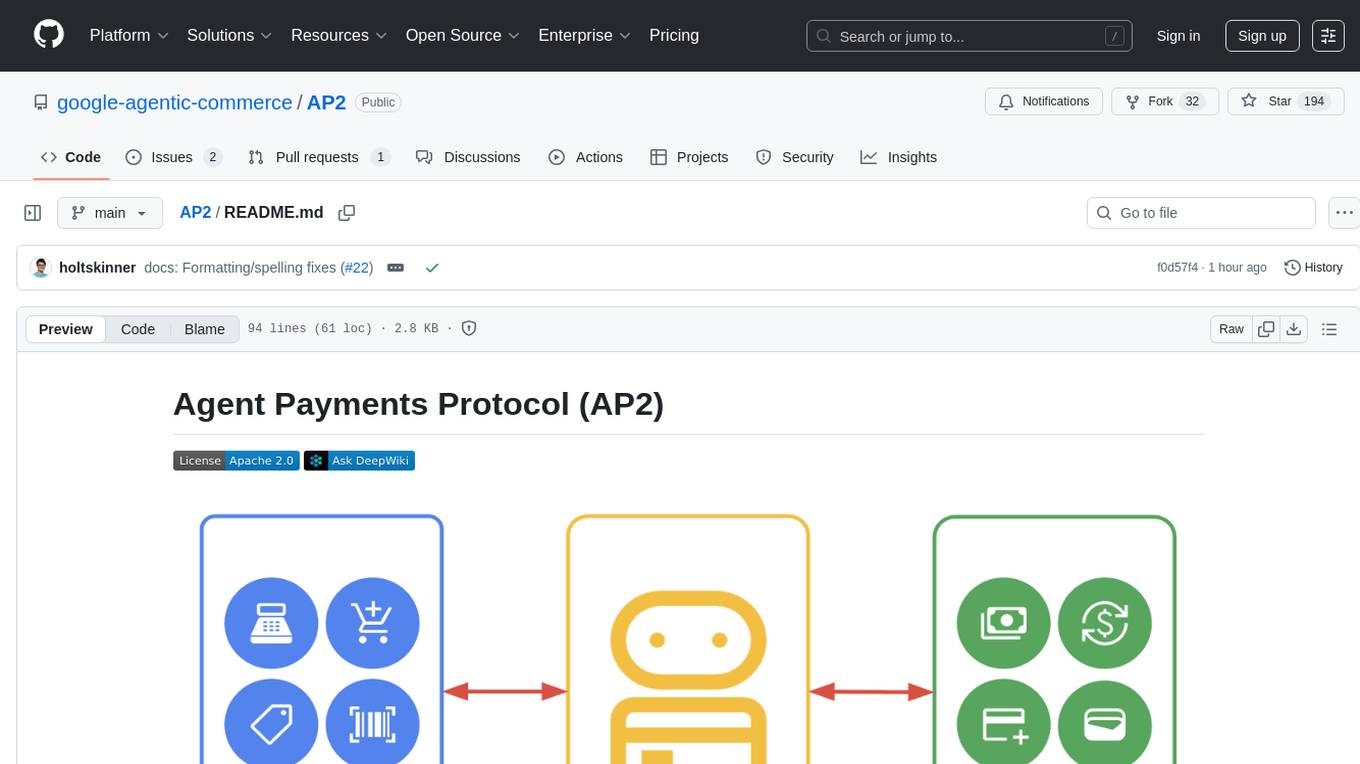
AP2
The Agent Payments Protocol (AP2) repository contains code samples and demos showcasing the protocol. It includes curated scenarios demonstrating key components, utilizing the Agent Development Kit (ADK) and Gemini 2.5 Flash. Users are free to use any tools to build agents. The repository features various agents and servers, with source code located in specific directories. Users can run scenarios by following README instructions and using run scripts. Additionally, the repository provides guidance on setting up prerequisites, obtaining a Google API key, and installing the AP2 types package.
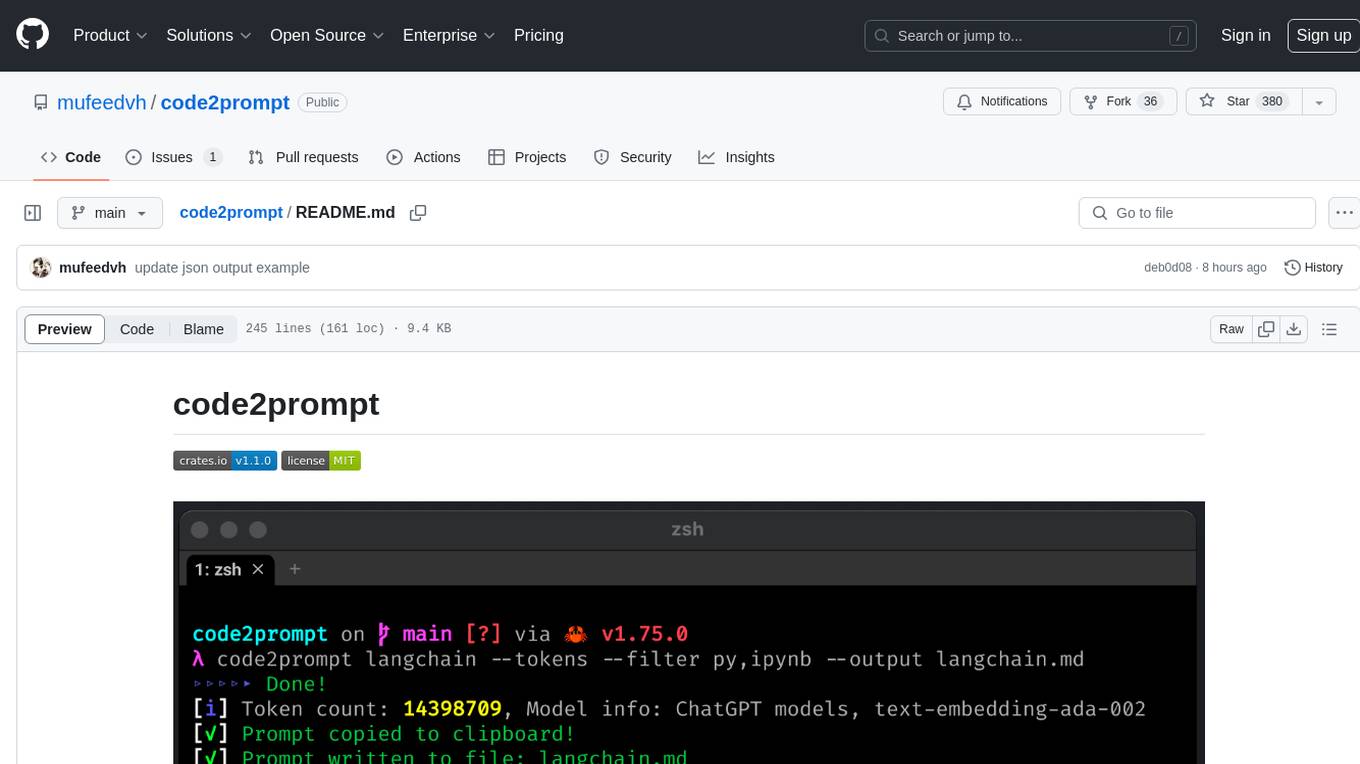
code2prompt
code2prompt is a command-line tool that converts your codebase into a single LLM prompt with a source tree, prompt templating, and token counting. It automates generating LLM prompts from codebases of any size, customizing prompt generation with Handlebars templates, respecting .gitignore, filtering and excluding files using glob patterns, displaying token count, including Git diff output, copying prompt to clipboard, saving prompt to an output file, excluding files and folders, adding line numbers to source code blocks, and more. It helps streamline the process of creating LLM prompts for code analysis, generation, and other tasks.
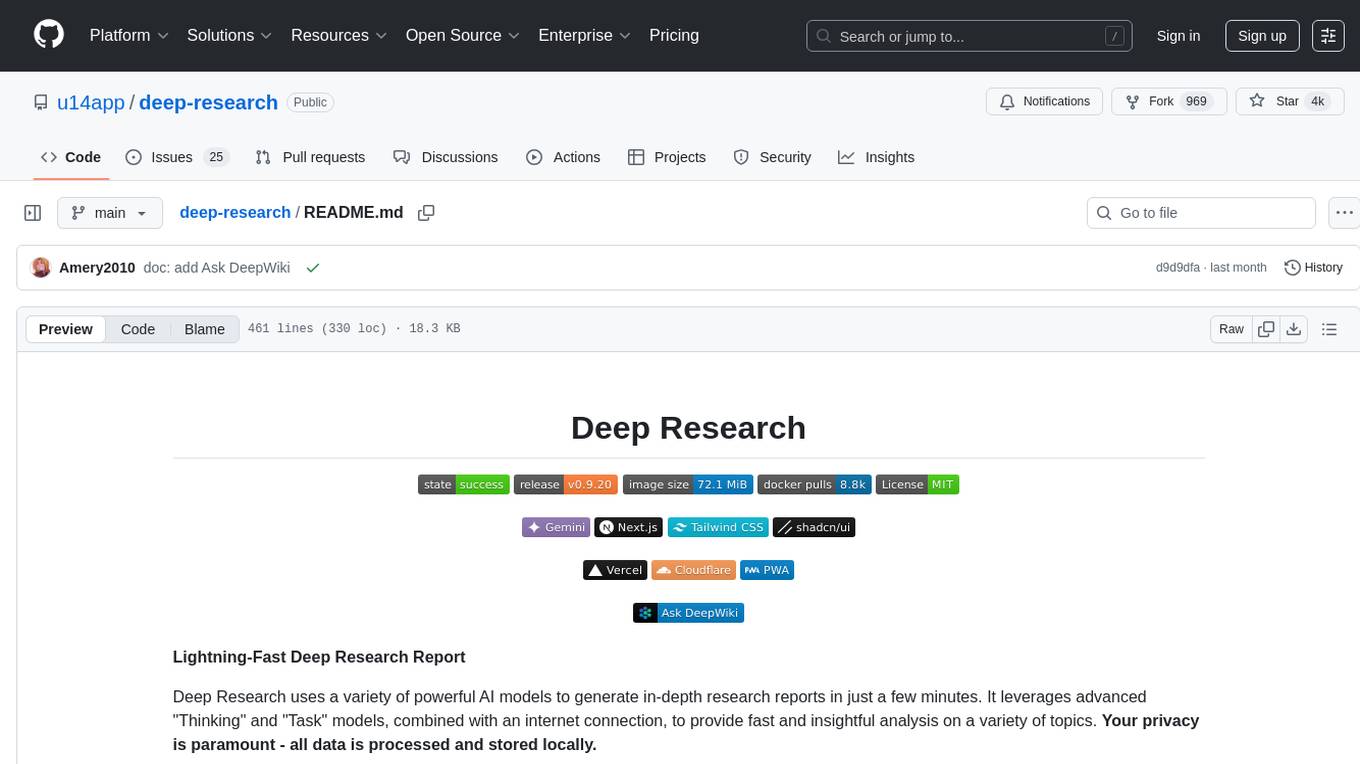
deep-research
Deep Research is a lightning-fast tool that uses powerful AI models to generate comprehensive research reports in just a few minutes. It leverages advanced 'Thinking' and 'Task' models, combined with an internet connection, to provide fast and insightful analysis on various topics. The tool ensures privacy by processing and storing all data locally. It supports multi-platform deployment, offers support for various large language models, web search functionality, knowledge graph generation, research history preservation, local and server API support, PWA technology, multi-key payload support, multi-language support, and is built with modern technologies like Next.js and Shadcn UI. Deep Research is open-source under the MIT License.
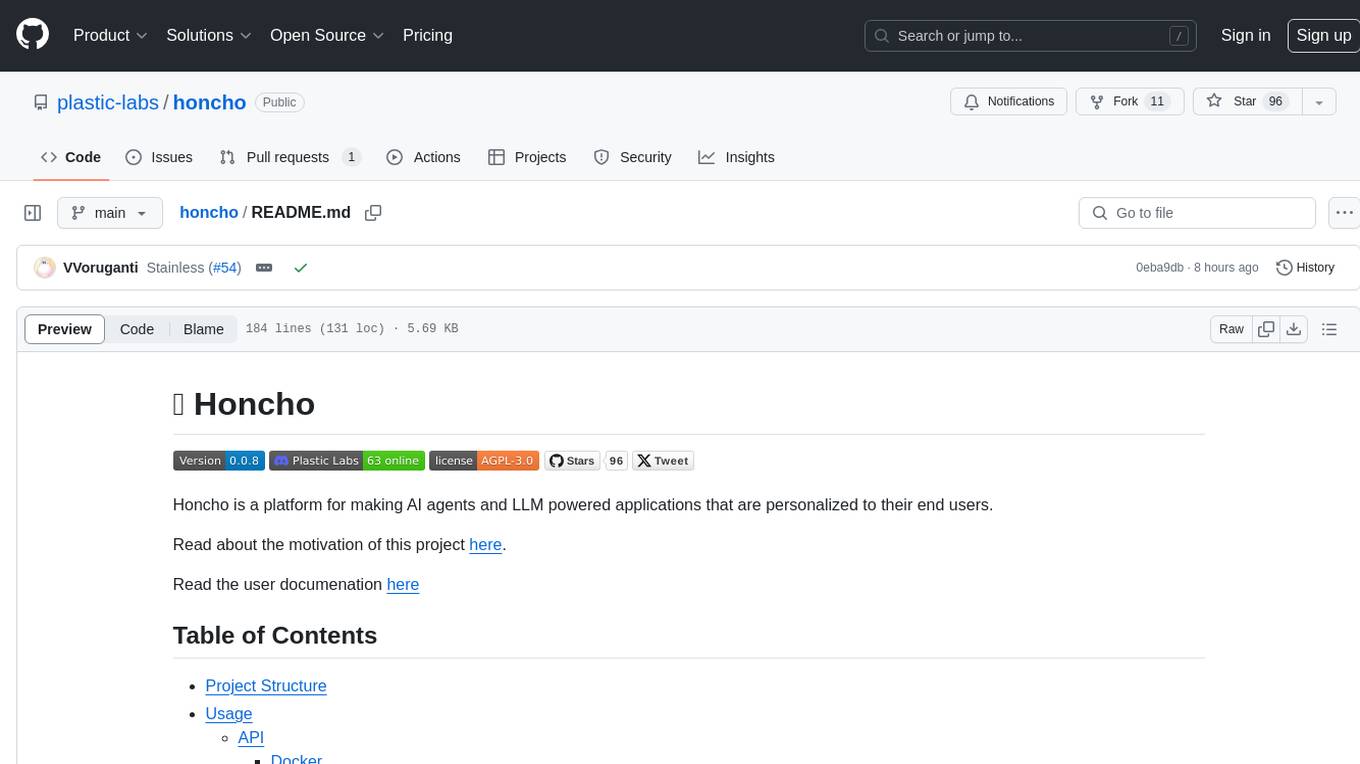
honcho
Honcho is a platform for creating personalized AI agents and LLM powered applications for end users. The repository is a monorepo containing the server/API for managing database interactions and storing application state, along with a Python SDK. It utilizes FastAPI for user context management and Poetry for dependency management. The API can be run using Docker or manually by setting environment variables. The client SDK can be installed using pip or Poetry. The project is open source and welcomes contributions, following a fork and PR workflow. Honcho is licensed under the AGPL-3.0 License.
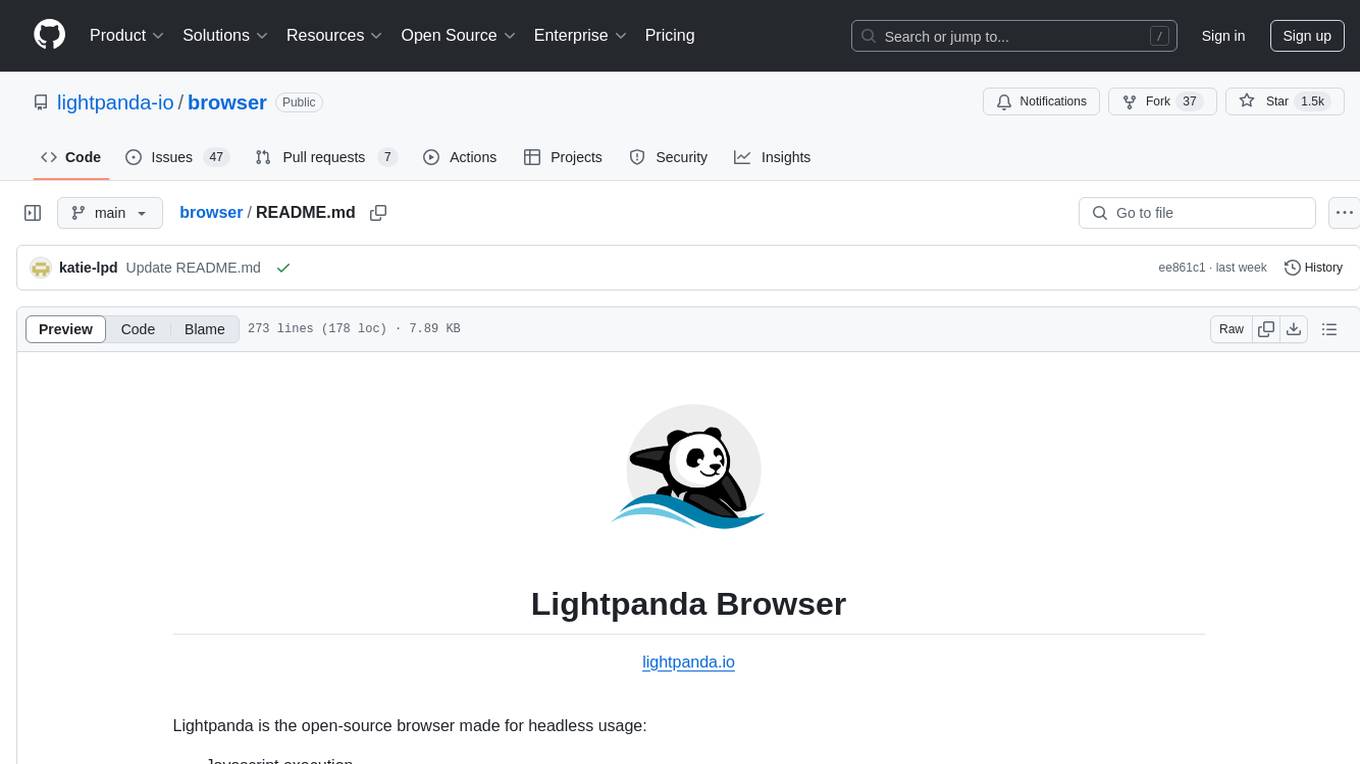
browser
Lightpanda Browser is an open-source headless browser designed for fast web automation, AI agents, LLM training, scraping, and testing. It features ultra-low memory footprint, exceptionally fast execution, and compatibility with Playwright and Puppeteer through CDP. Built for performance, Lightpanda offers Javascript execution, support for Web APIs, and is optimized for minimal memory usage. It is a modern solution for web scraping and automation tasks, providing a lightweight alternative to traditional browsers like Chrome.
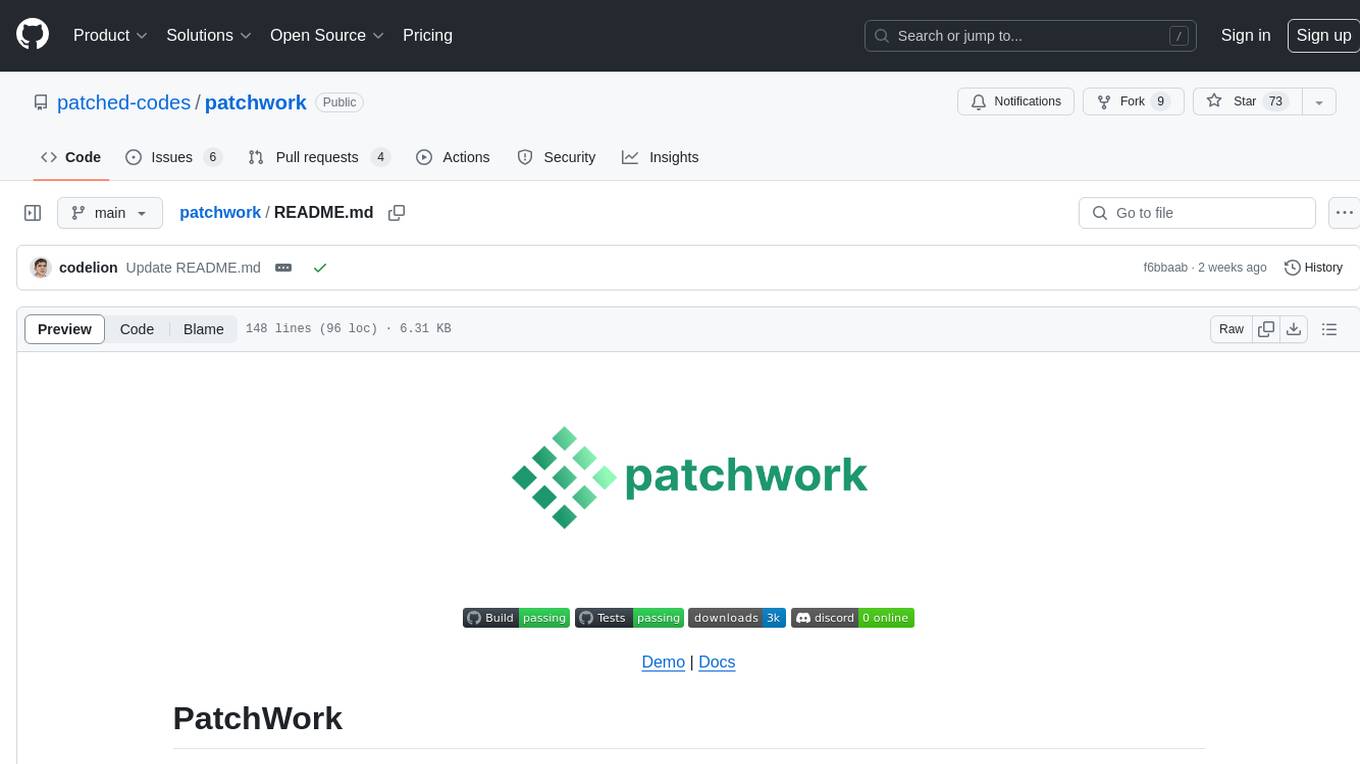
patchwork
PatchWork is an open-source framework designed for automating development tasks using large language models. It enables users to automate workflows such as PR reviews, bug fixing, security patching, and more through a self-hosted CLI agent and preferred LLMs. The framework consists of reusable atomic actions called Steps, customizable LLM prompts known as Prompt Templates, and LLM-assisted automations called Patchflows. Users can run Patchflows locally in their CLI/IDE or as part of CI/CD pipelines. PatchWork offers predefined patchflows like AutoFix, PRReview, GenerateREADME, DependencyUpgrade, and ResolveIssue, with the flexibility to create custom patchflows. Prompt templates are used to pass queries to LLMs and can be customized. Contributions to new patchflows, steps, and the core framework are encouraged, with chat assistants available to aid in the process. The roadmap includes expanding the patchflow library, introducing a debugger and validation module, supporting large-scale code embeddings, parallelization, fine-tuned models, and an open-source GUI. PatchWork is licensed under AGPL-3.0 terms, while custom patchflows and steps can be shared using the Apache-2.0 licensed patchwork template repository.
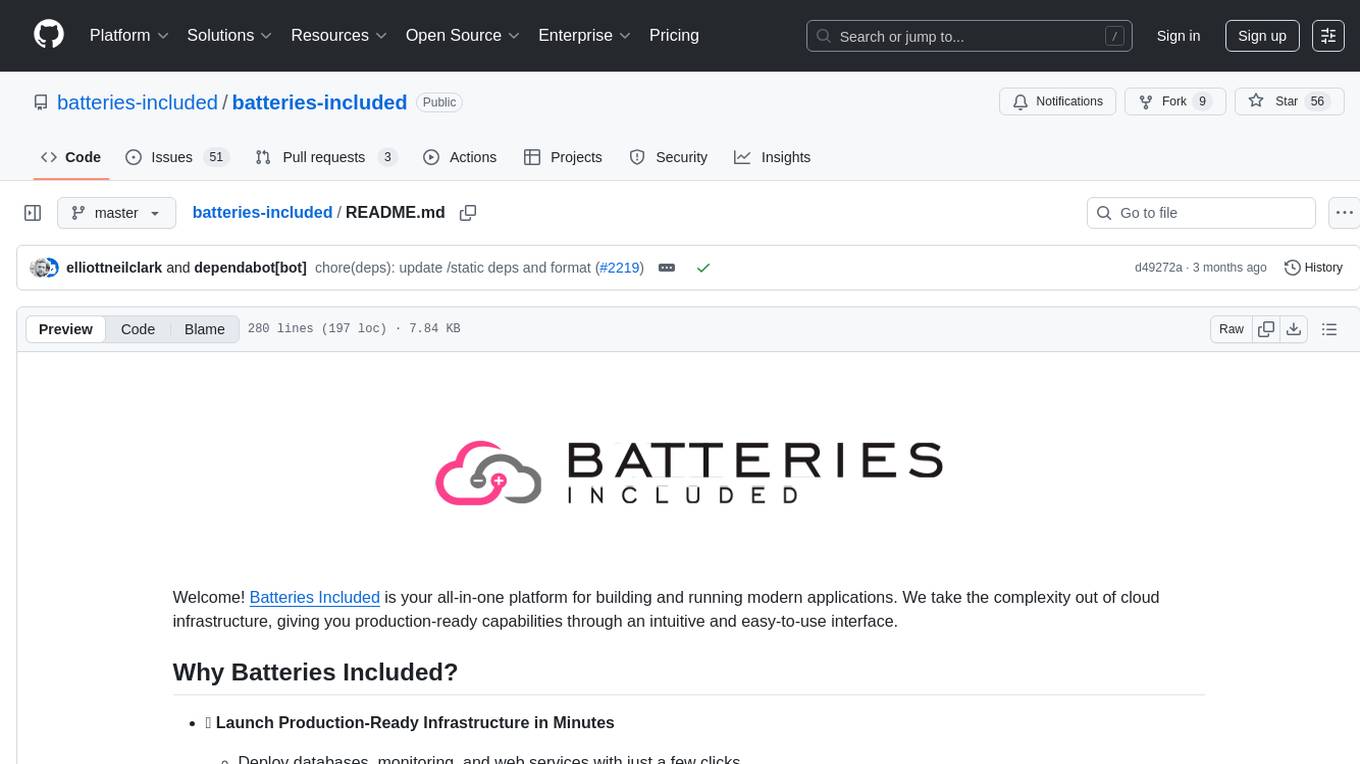
batteries-included
Batteries Included is an all-in-one platform for building and running modern applications, simplifying cloud infrastructure complexity. It offers production-ready capabilities through an intuitive interface, focusing on automation, security, and enterprise-grade features. The platform includes databases like PostgreSQL and Redis, AI/ML capabilities with Jupyter notebooks, web services deployment, security features like SSL/TLS management, and monitoring tools like Grafana dashboards. Batteries Included is designed to streamline infrastructure setup and management, allowing users to concentrate on application development without dealing with complex configurations.
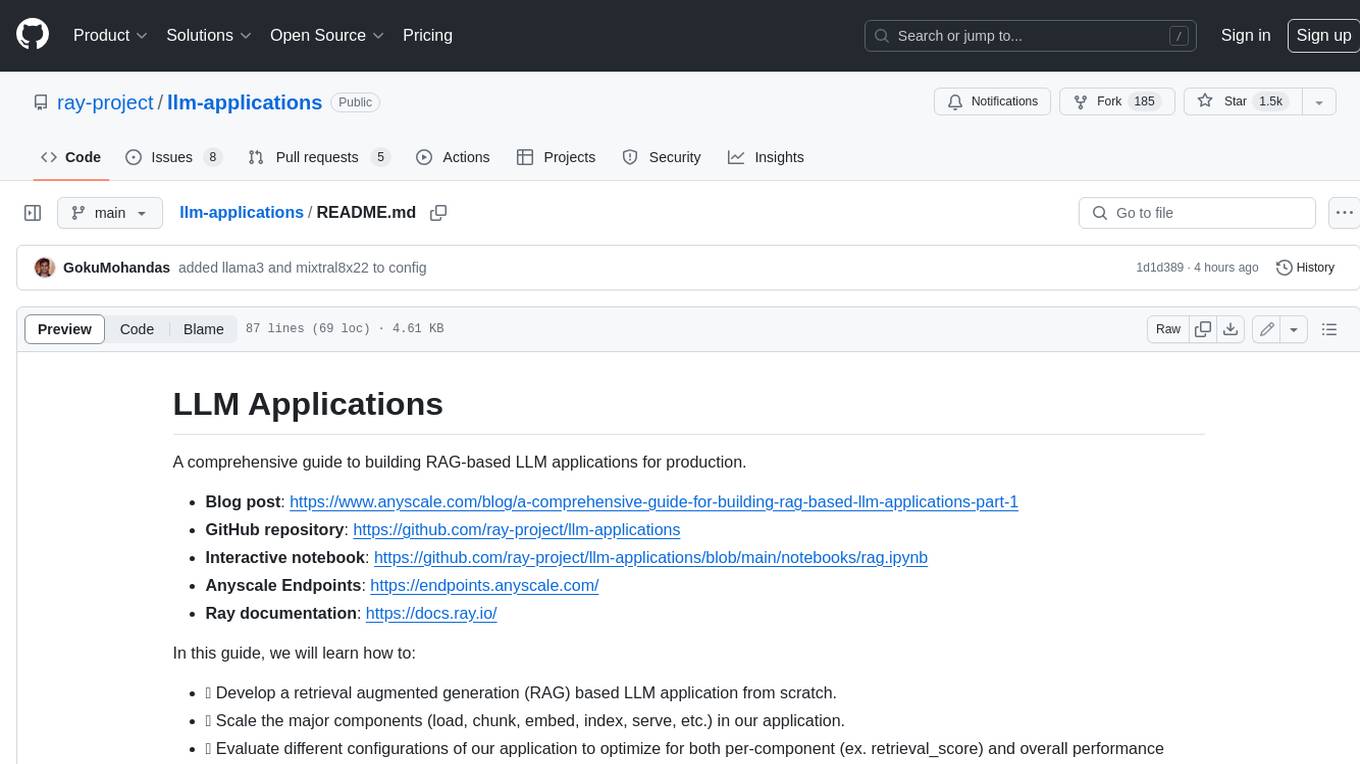
llm-applications
A comprehensive guide to building Retrieval Augmented Generation (RAG)-based LLM applications for production. This guide covers developing a RAG-based LLM application from scratch, scaling the major components, evaluating different configurations, implementing LLM hybrid routing, serving the application in a highly scalable and available manner, and sharing the impacts LLM applications have had on products.
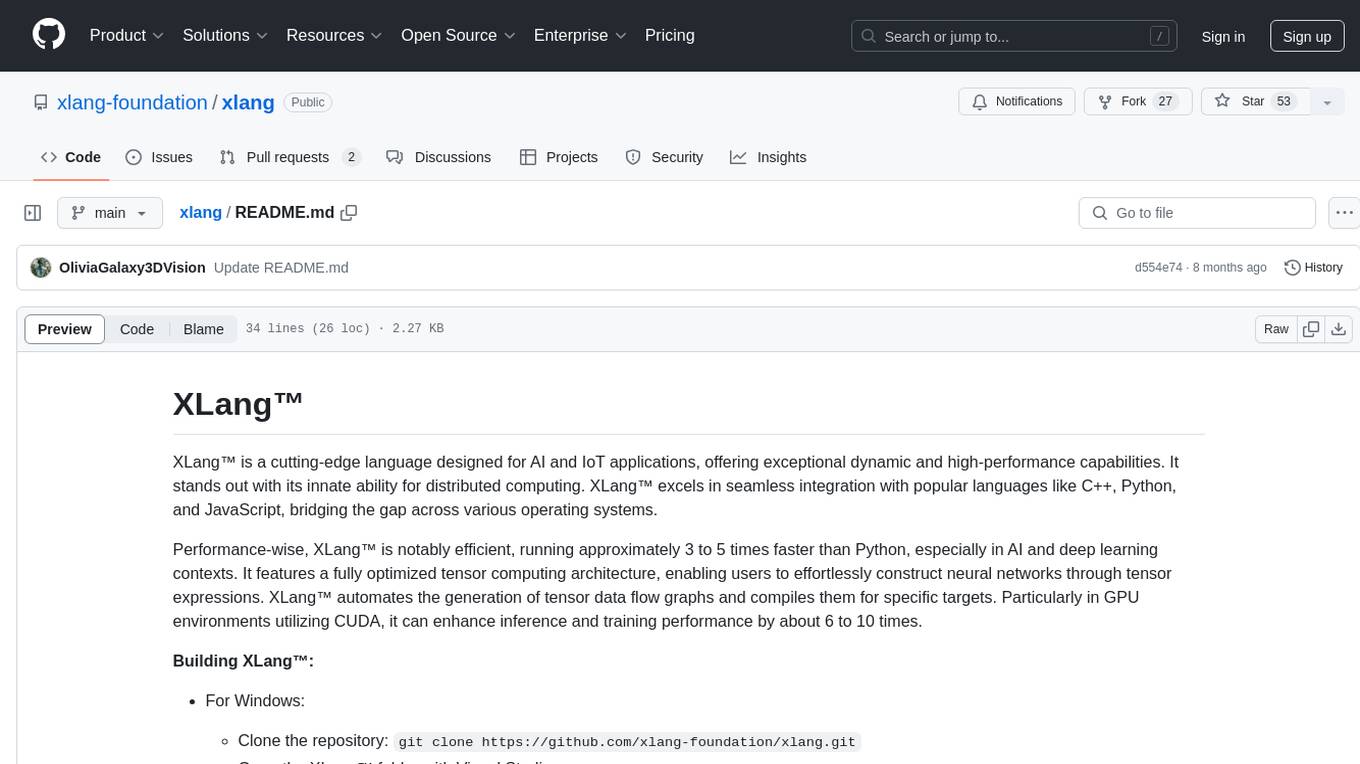
xlang
XLang™ is a cutting-edge language designed for AI and IoT applications, offering exceptional dynamic and high-performance capabilities. It excels in distributed computing and seamless integration with popular languages like C++, Python, and JavaScript. Notably efficient, running 3 to 5 times faster than Python in AI and deep learning contexts. Features optimized tensor computing architecture for constructing neural networks through tensor expressions. Automates tensor data flow graph generation and compilation for specific targets, enhancing GPU performance by 6 to 10 times in CUDA environments.
For similar tasks
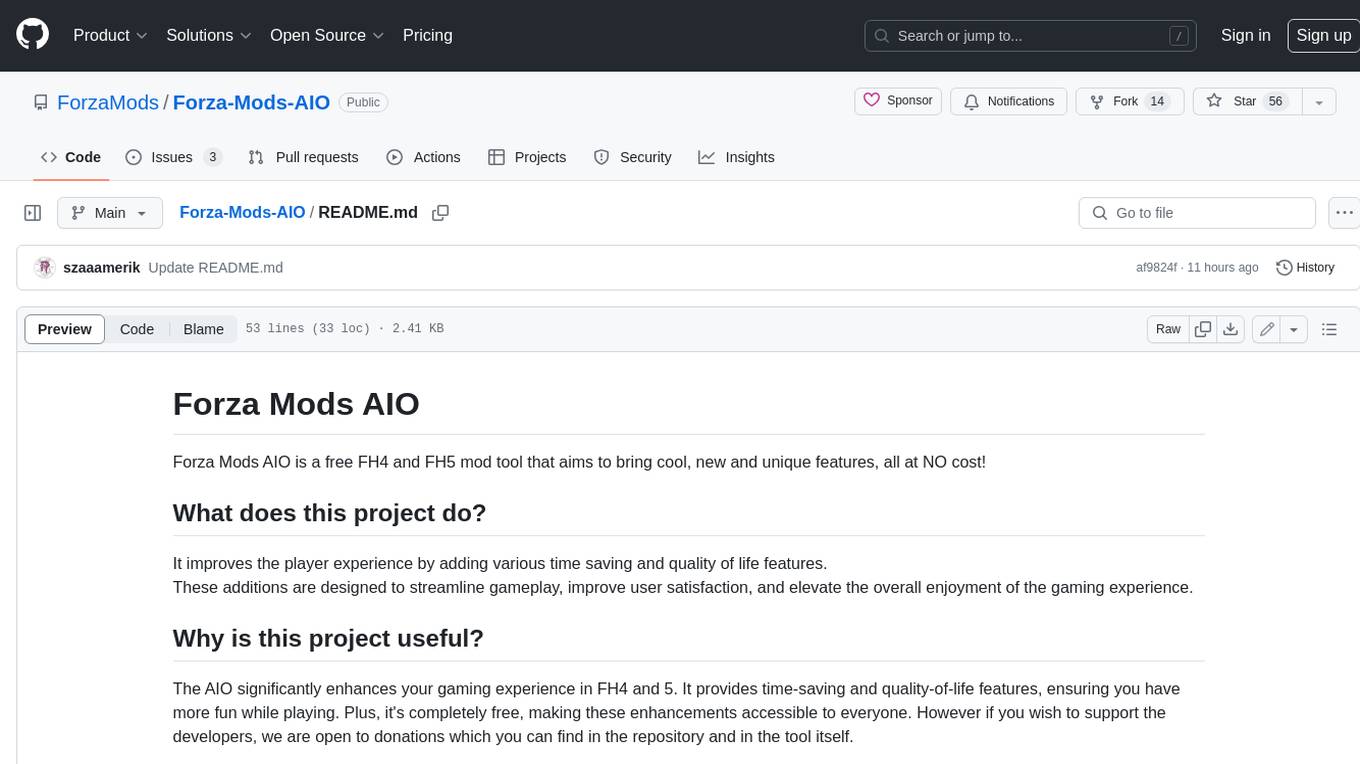
Forza-Mods-AIO
Forza Mods AIO is a free and open-source tool that enhances the gaming experience in Forza Horizon 4 and 5. It offers a range of time-saving and quality-of-life features, making gameplay more enjoyable and efficient. The tool is designed to streamline various aspects of the game, improving user satisfaction and overall enjoyment.
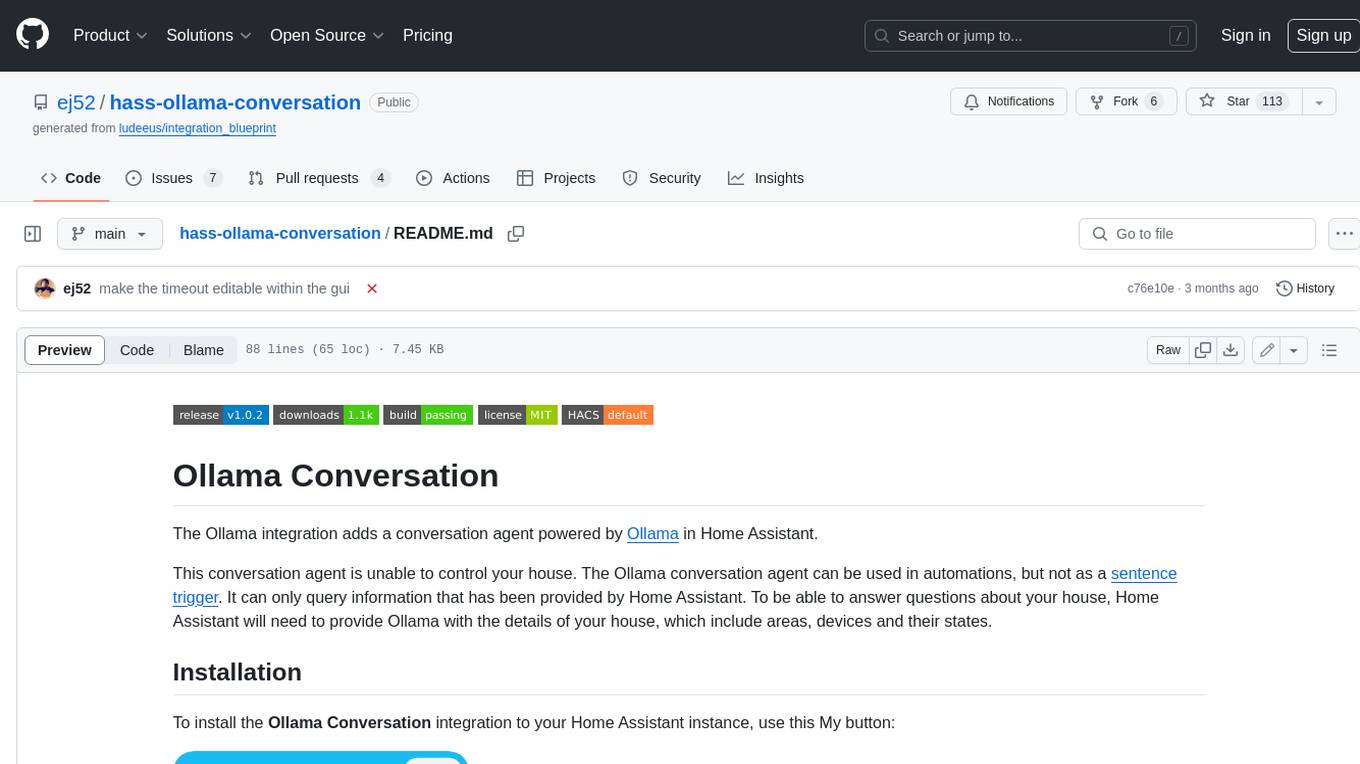
hass-ollama-conversation
The Ollama Conversation integration adds a conversation agent powered by Ollama in Home Assistant. This agent can be used in automations to query information provided by Home Assistant about your house, including areas, devices, and their states. Users can install the integration via HACS and configure settings such as API timeout, model selection, context size, maximum tokens, and other parameters to fine-tune the responses generated by the AI language model. Contributions to the project are welcome, and discussions can be held on the Home Assistant Community platform.
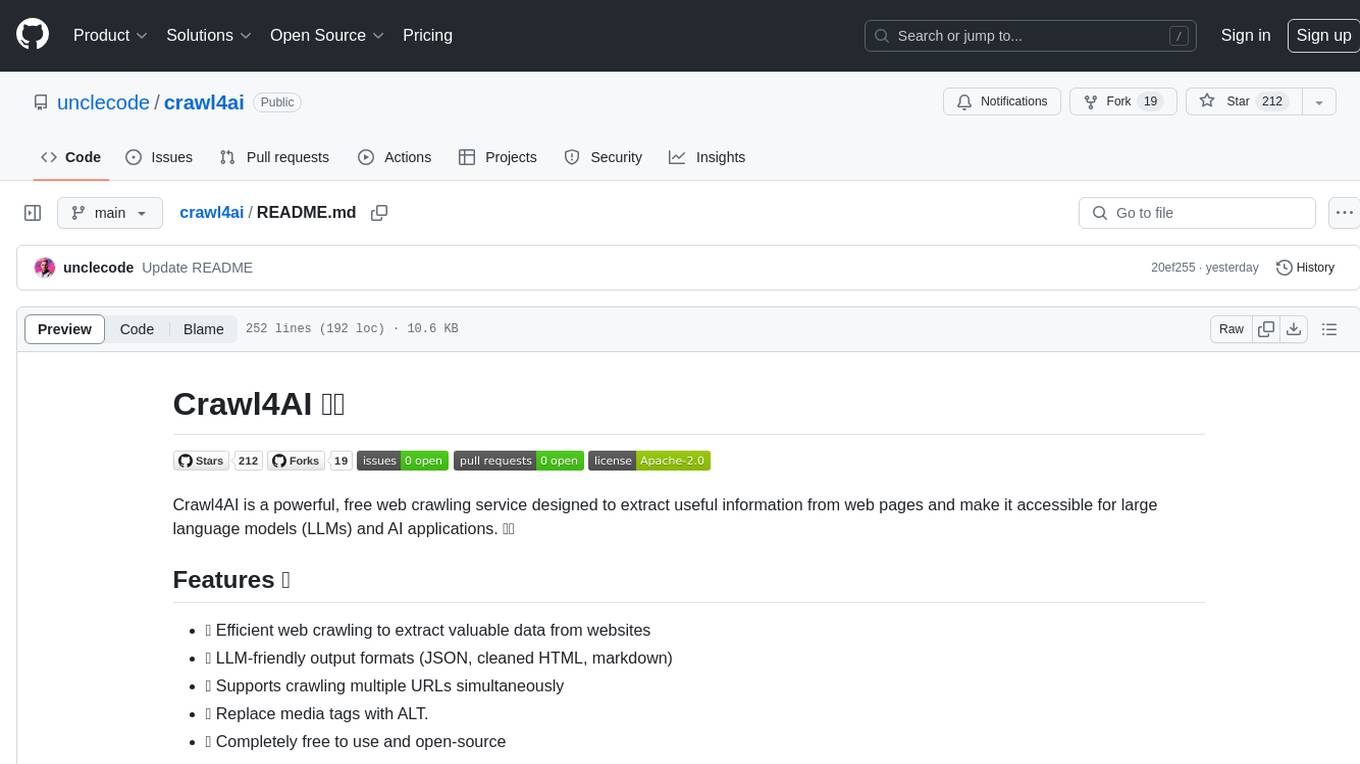
crawl4ai
Crawl4AI is a powerful and free web crawling service that extracts valuable data from websites and provides LLM-friendly output formats. It supports crawling multiple URLs simultaneously, replaces media tags with ALT, and is completely free to use and open-source. Users can integrate Crawl4AI into Python projects as a library or run it as a standalone local server. The tool allows users to crawl and extract data from specified URLs using different providers and models, with options to include raw HTML content, force fresh crawls, and extract meaningful text blocks. Configuration settings can be adjusted in the `crawler/config.py` file to customize providers, API keys, chunk processing, and word thresholds. Contributions to Crawl4AI are welcome from the open-source community to enhance its value for AI enthusiasts and developers.
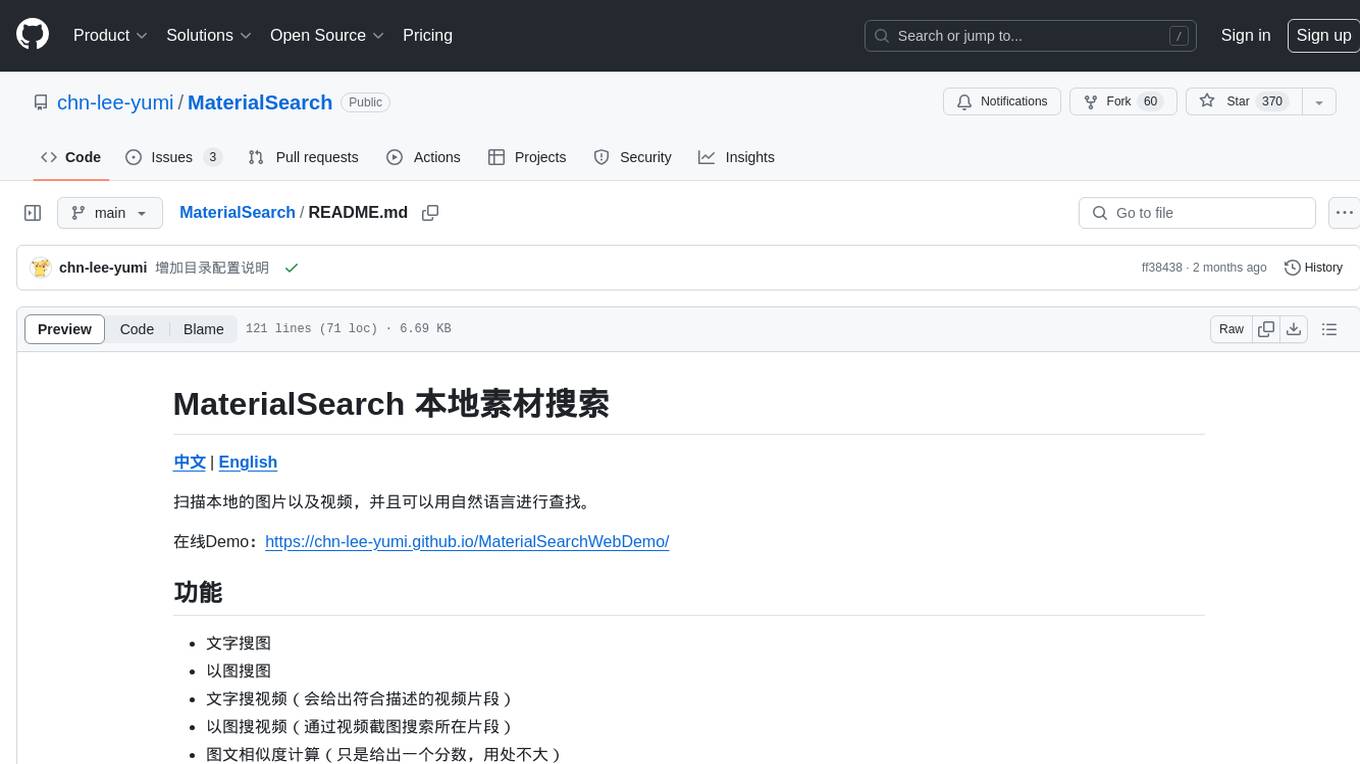
MaterialSearch
MaterialSearch is a tool for searching local images and videos using natural language. It provides functionalities such as text search for images, image search for images, text search for videos (providing matching video clips), image search for videos (searching for the segment in a video through a screenshot), image-text similarity calculation, and Pexels video search. The tool can be deployed through the source code or Docker image, and it supports GPU acceleration. Users can configure the tool through environment variables or a .env file. The tool is still under development, and configurations may change frequently. Users can report issues or suggest improvements through issues or pull requests.
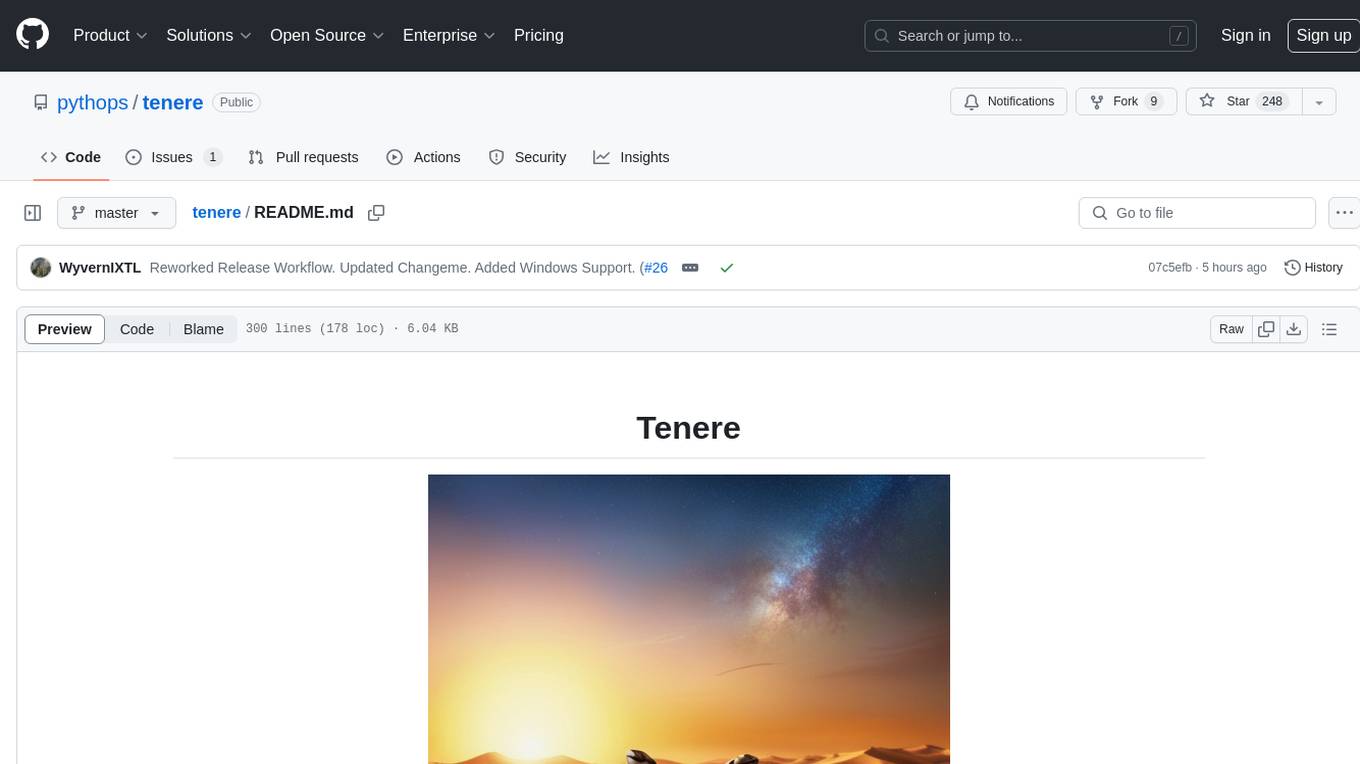
tenere
Tenere is a TUI interface for Language Model Libraries (LLMs) written in Rust. It provides syntax highlighting, chat history, saving chats to files, Vim keybindings, copying text from/to clipboard, and supports multiple backends. Users can configure Tenere using a TOML configuration file, set key bindings, and use different LLMs such as ChatGPT, llama.cpp, and ollama. Tenere offers default key bindings for global and prompt modes, with features like starting a new chat, saving chats, scrolling, showing chat history, and quitting the app. Users can interact with the prompt in different modes like Normal, Visual, and Insert, with various key bindings for navigation, editing, and text manipulation.
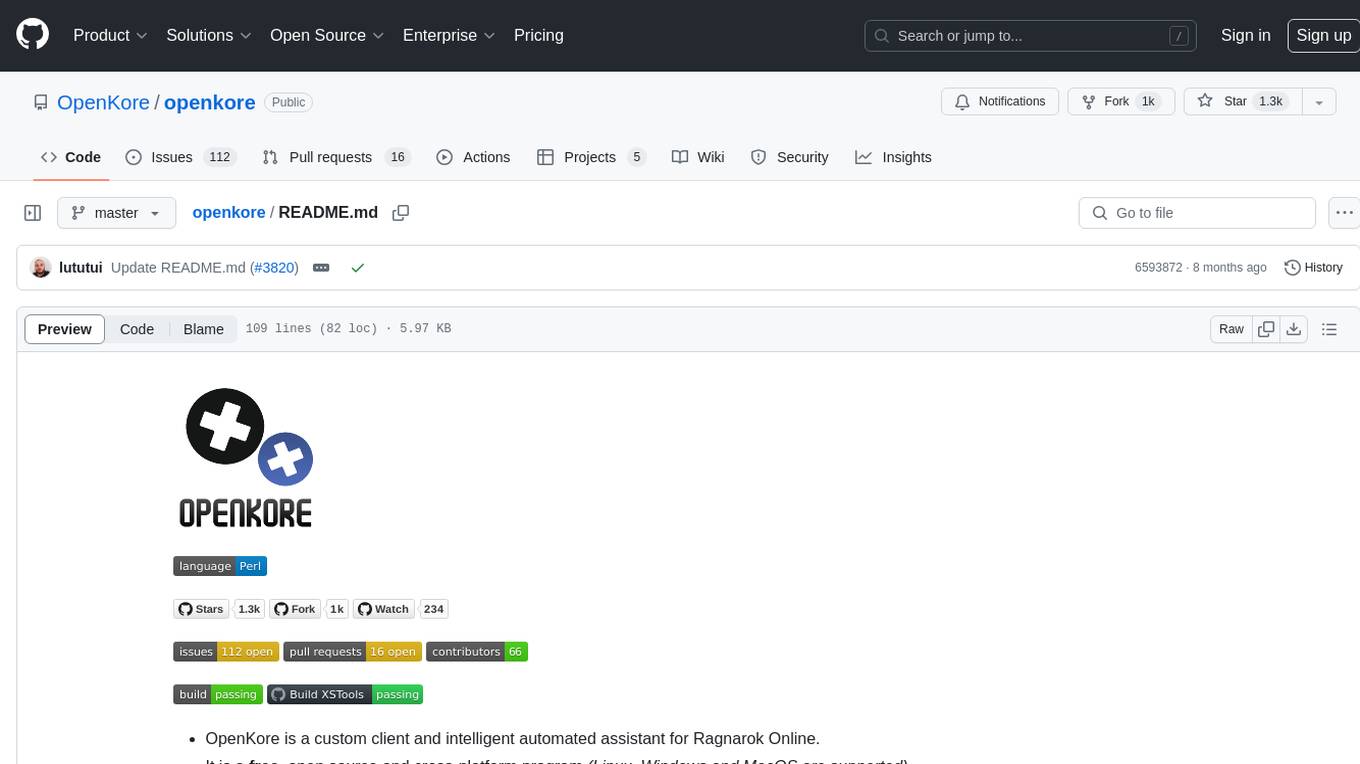
openkore
OpenKore is a custom client and intelligent automated assistant for Ragnarok Online. It is a free, open source, and cross-platform program (Linux, Windows, and MacOS are supported). To run OpenKore, you need to download and extract it or clone the repository using Git. Configure OpenKore according to the documentation and run openkore.pl to start. The tool provides a FAQ section for troubleshooting, guidelines for reporting issues, and information about botting status on official servers. OpenKore is developed by a global team, and contributions are welcome through pull requests. Various community resources are available for support and communication. Users are advised to comply with the GNU General Public License when using and distributing the software.
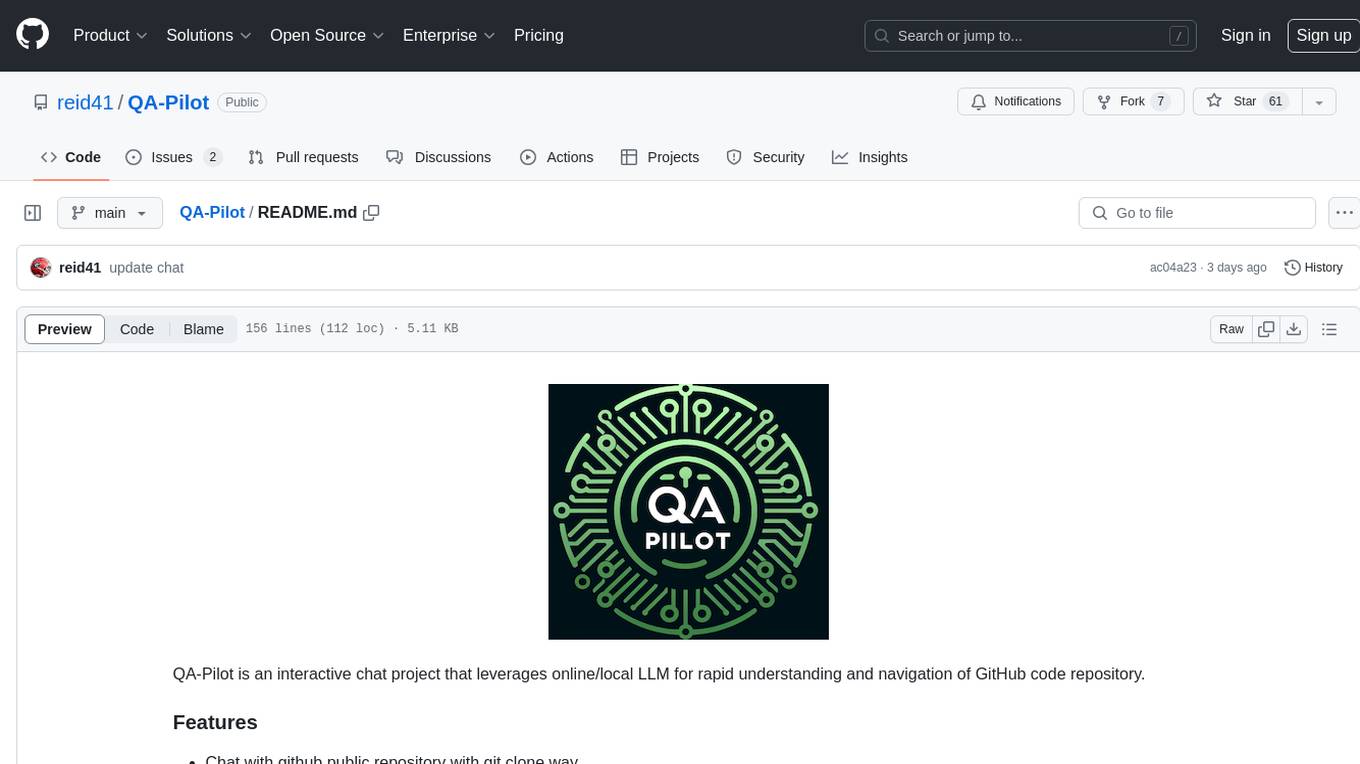
QA-Pilot
QA-Pilot is an interactive chat project that leverages online/local LLM for rapid understanding and navigation of GitHub code repository. It allows users to chat with GitHub public repositories using a git clone approach, store chat history, configure settings easily, manage multiple chat sessions, and quickly locate sessions with a search function. The tool integrates with `codegraph` to view Python files and supports various LLM models such as ollama, openai, mistralai, and localai. The project is continuously updated with new features and improvements, such as converting from `flask` to `fastapi`, adding `localai` API support, and upgrading dependencies like `langchain` and `Streamlit` to enhance performance.
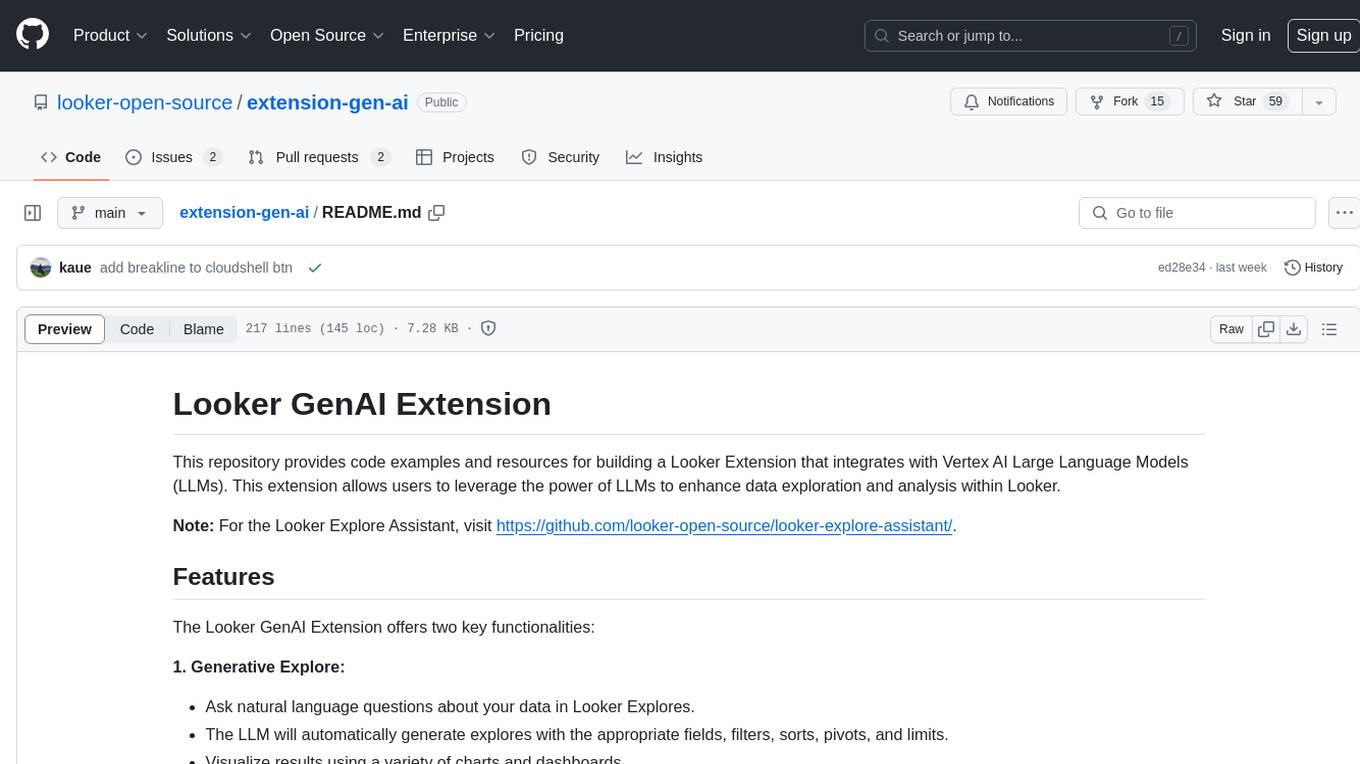
extension-gen-ai
The Looker GenAI Extension provides code examples and resources for building a Looker Extension that integrates with Vertex AI Large Language Models (LLMs). Users can leverage the power of LLMs to enhance data exploration and analysis within Looker. The extension offers generative explore functionality to ask natural language questions about data and generative insights on dashboards to analyze data by asking questions. It leverages components like BQML Remote Models, BQML Remote UDF with Vertex AI, and Custom Fine Tune Model for different integration options. Deployment involves setting up infrastructure with Terraform and deploying the Looker Extension by creating a Looker project, copying extension files, configuring BigQuery connection, connecting to Git, and testing the extension. Users can save example prompts and configure user settings for the extension. Development of the Looker Extension environment includes installing dependencies, starting the development server, and building for production.
For similar jobs

weave
Weave is a toolkit for developing Generative AI applications, built by Weights & Biases. With Weave, you can log and debug language model inputs, outputs, and traces; build rigorous, apples-to-apples evaluations for language model use cases; and organize all the information generated across the LLM workflow, from experimentation to evaluations to production. Weave aims to bring rigor, best-practices, and composability to the inherently experimental process of developing Generative AI software, without introducing cognitive overhead.

LLMStack
LLMStack is a no-code platform for building generative AI agents, workflows, and chatbots. It allows users to connect their own data, internal tools, and GPT-powered models without any coding experience. LLMStack can be deployed to the cloud or on-premise and can be accessed via HTTP API or triggered from Slack or Discord.

VisionCraft
The VisionCraft API is a free API for using over 100 different AI models. From images to sound.

kaito
Kaito is an operator that automates the AI/ML inference model deployment in a Kubernetes cluster. It manages large model files using container images, avoids tuning deployment parameters to fit GPU hardware by providing preset configurations, auto-provisions GPU nodes based on model requirements, and hosts large model images in the public Microsoft Container Registry (MCR) if the license allows. Using Kaito, the workflow of onboarding large AI inference models in Kubernetes is largely simplified.

PyRIT
PyRIT is an open access automation framework designed to empower security professionals and ML engineers to red team foundation models and their applications. It automates AI Red Teaming tasks to allow operators to focus on more complicated and time-consuming tasks and can also identify security harms such as misuse (e.g., malware generation, jailbreaking), and privacy harms (e.g., identity theft). The goal is to allow researchers to have a baseline of how well their model and entire inference pipeline is doing against different harm categories and to be able to compare that baseline to future iterations of their model. This allows them to have empirical data on how well their model is doing today, and detect any degradation of performance based on future improvements.

tabby
Tabby is a self-hosted AI coding assistant, offering an open-source and on-premises alternative to GitHub Copilot. It boasts several key features: * Self-contained, with no need for a DBMS or cloud service. * OpenAPI interface, easy to integrate with existing infrastructure (e.g Cloud IDE). * Supports consumer-grade GPUs.

spear
SPEAR (Simulator for Photorealistic Embodied AI Research) is a powerful tool for training embodied agents. It features 300 unique virtual indoor environments with 2,566 unique rooms and 17,234 unique objects that can be manipulated individually. Each environment is designed by a professional artist and features detailed geometry, photorealistic materials, and a unique floor plan and object layout. SPEAR is implemented as Unreal Engine assets and provides an OpenAI Gym interface for interacting with the environments via Python.

Magick
Magick is a groundbreaking visual AIDE (Artificial Intelligence Development Environment) for no-code data pipelines and multimodal agents. Magick can connect to other services and comes with nodes and templates well-suited for intelligent agents, chatbots, complex reasoning systems and realistic characters.
